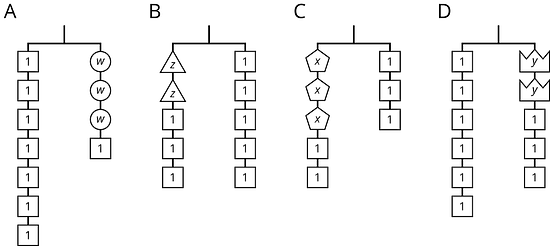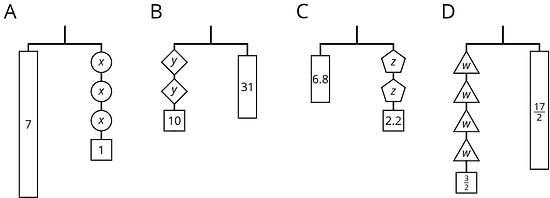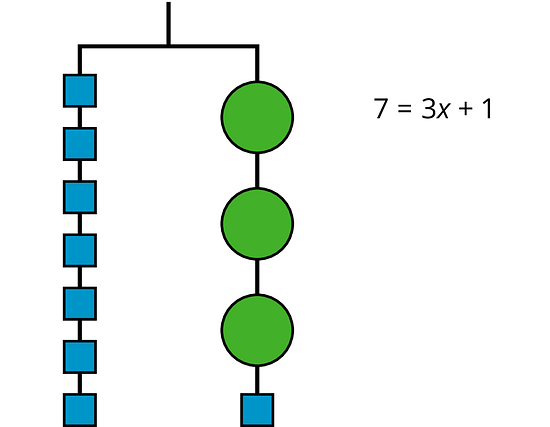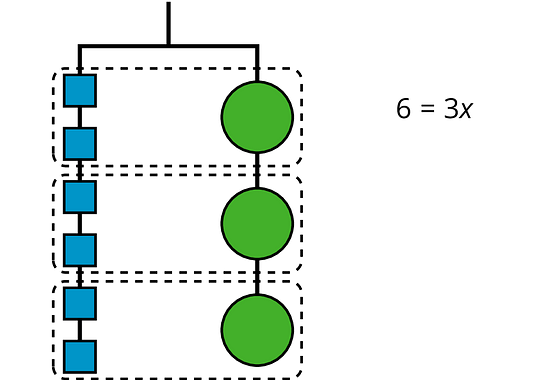Lesson 7Reasoning about Solving Equations (Part 1)
Let’s see how a balanced hanger is like an equation and how moving its weights is like solving the equation.
Learning Targets:
- I can explain how a balanced hanger and an equation represent the same situation.
- I can find an unknown weight on a hanger diagram and solve an equation that represents the diagram.
- I can write an equation that describes the weights on a balanced hanger.
7.1 Hanger Diagrams

In the two diagrams, all the triangles weigh the same and all the squares weigh the same.
For each diagram, come up with . . .
- One thing that must be true
- One thing that could be true
- One thing that cannot possibly be true
7.2 Hanger and Equation Matching
On each balanced hanger, figures with the same letter have the same weight.

- Match each hanger to an equation. Complete the equation by writing , , , or in the empty box.
- Find the solution to each equation. Use the hanger to explain what the solution means.
7.3 Use Hangers to Understand Equation Solving

Here are some balanced hangers where each piece is labeled with its weight. For each diagram:
- Write an equation.
- Explain how to figure out the weight of a piece labeled with a letter by reasoning about the diagram.
- Explain how to figure out the weight of a piece labeled with a letter by reasoning about the equation.
Are you ready for more?
When you have the time, visit the site https://solveme.edc.org/Mobiles.html to solve some trickier puzzles that use hanger diagrams like the ones in this lesson. You can even build new ones. (If you want to do this during class, check with your teacher first!)
Lesson 7 Summary
In this lesson, we worked with two ways to show that two amounts are equal: a balanced hanger and an equation. We can use a balanced hanger to think about steps to finding an unknown amount in an associated equation.
The hanger shows a total weight of 7 units on one side that is balanced with 3 equal, unknown weights and a 1-unit weight on the other. An equation that represents the relationship is .

We can remove a weight of 1 unit from each side and the hanger will stay balanced. This is the same as subtracting 1 from each side of the equation.

An equation for the new balanced hanger is .

So the hanger will balance with of the weight on each side: .

The two sides of the hanger balance with these weights: 6 1-unit weights on one side and 3 weights of unknown size on the other side.

Here is a concise way to write the steps above:
Lesson 7 Practice Problems
There is a proportional relationship between the volume of a sample of helium in liters and the mass of that sample in grams. If the mass of a sample is 5 grams, its volume is 28 liters. (5, 28) is shown on the graph below.
- What is the constant of proportionality in this relationship?
- In this situation, what is the meaning of the number you found in part a?
- Add at least three more points to the graph above, and label with their coordinates.
- Write an equation that shows the relationship between the mass of a sample of helium and its volume. Use for mass and for volume.
Explain how the parts of the balanced hanger compare to the parts of the equation.

- Here is a hanger:

- Write an equation to represent the hanger.
- Draw more hangers to show each step you would take to find . Explain your reasoning.
- Write an equation to describe each hanger you drew. Describe how each equation matches its hanger.